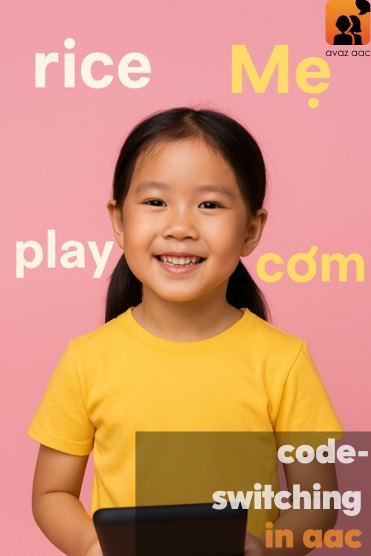When bilingual or trilingual children use Augmentative and Alternative Communication (AAC), they bring their unique blend of languages with them often in the same sentence. This natural process, called code-switching, is not a problem to be fixed. It’s a powerful way to communicate, connect, and express identity.
In this blog, we explore how code-switching shapes AAC use and what we can do to design better tools for multilingual users.


What is Code-Switching?
Code-switching is when a person alternates between two or more languages within a conversation sometimes within a single sentence or phrase.
For example:
“Ba ơi, can I play now?”
(Dad, can I play now?)
Or in a trilingual home:
“Mẹ ơi, quiero rice.”
(Mom, I want rice – blending Vietnamese, Spanish, and English.)
For many children growing up in multilingual environments, this is completely natural. It reflects who they speak to, what they’re trying to express, and what feels most familiar.
Why Code-Switching Matters in AAC
Most AAC systems are built for monolingual communication. They expect users to select a language and stay within it. But bilingual and trilingual AAC users don’t always want to or need to.
Here’s how code-switching shows up in AAC use:
1. Children May Know a Word in One Language but Not the Other
A Vietnamese-English user may know “mì” (noodles) but not yet have learned the word “noodles” in English. Their AAC system needs to let them say what they know, not what the system assumes they know.
Problem: If the device only supports English vocabulary, the child can’t express what they want.
Solution: Include culturally relevant vocabulary from all languages, not just direct translations.
2. Code-Switching Supports Emotional Expression
Many multilingual children use one language at home and another at school. They may use their home language like Tamil, Vietnamese, or Spanish to express comfort, frustration, or excitement.
AAC systems should allow children to express feelings in the language that feels safest or strongest.
Tip: Add commonly used interjections or feeling words in all relevant languages.
3. Sentence Construction May Cross Languages
Multilingual users often blend sentence structure, like saying:
“Con muốn eat cake.”
(Vietnamese-English: I want to eat cake.)
This kind of “hybrid grammar” is typical and often used for efficiency, especially if a word is easier to retrieve in one language.
Problem: Most AAC setups don’t support switching mid-sentence.
Solution: Let users toggle languages without breaking flow. Enable mixed-language layouts or allow frequently code-switched phrases to be stored.
How to Support Code-Switching in AAC Design
Here’s what helps:
Fast Language Switching
Avoid hidden settings or deep menus. Let users tap once to switch languages or better, allow both on the same page.
Preserve Motor Planning
If possible, keep button positions consistent across languages to reduce cognitive load.
Support Mixed-Language Phrases
Pre-load commonly mixed phrases (e.g., “I want cơm” / “Tôi muốn play”). Let caregivers or users add their own.
Model Code-Switching
Families, educators, and therapists can model natural code-switching during AAC use, showing that it’s accepted and powerful.
Let Children Speak in Their Whole Voice
For multilingual AAC users, code-switching is not confusion, it’s connection. It reflects their relationships, routines, and reality.
Designing AAC to embrace code-switching:
- Reduces frustration
- Supports identity
- Promotes natural language development
- Builds communication bridges across home and school
At Avaz, We Embrace Code-Switching
Avaz AAC supports:
- Easy toggling between languages like English and Vietnamese
- Customizable vocabulary for culture-specific words
- Layouts that support code-switching and motor planning
Whether it’s “Can I ăn cơm?” or “Mẹ, I’m happy” — we want every child to speak freely, confidently, and in the language(s) that feel most like them.
📚 References
- Diaz, L. Why Bilingual AAC Users Need Access to Both Languages.
- Boyle, S. Designing AAC Systems for Bilingual Users.
- Soto, G. & Yu, B. (2014). Considerations for the Provision of AAC Services to Bilingual Children.
- Gutierrez-Clellen, V. et al. (2009). Code-switching in bilingual children with language impairment.



